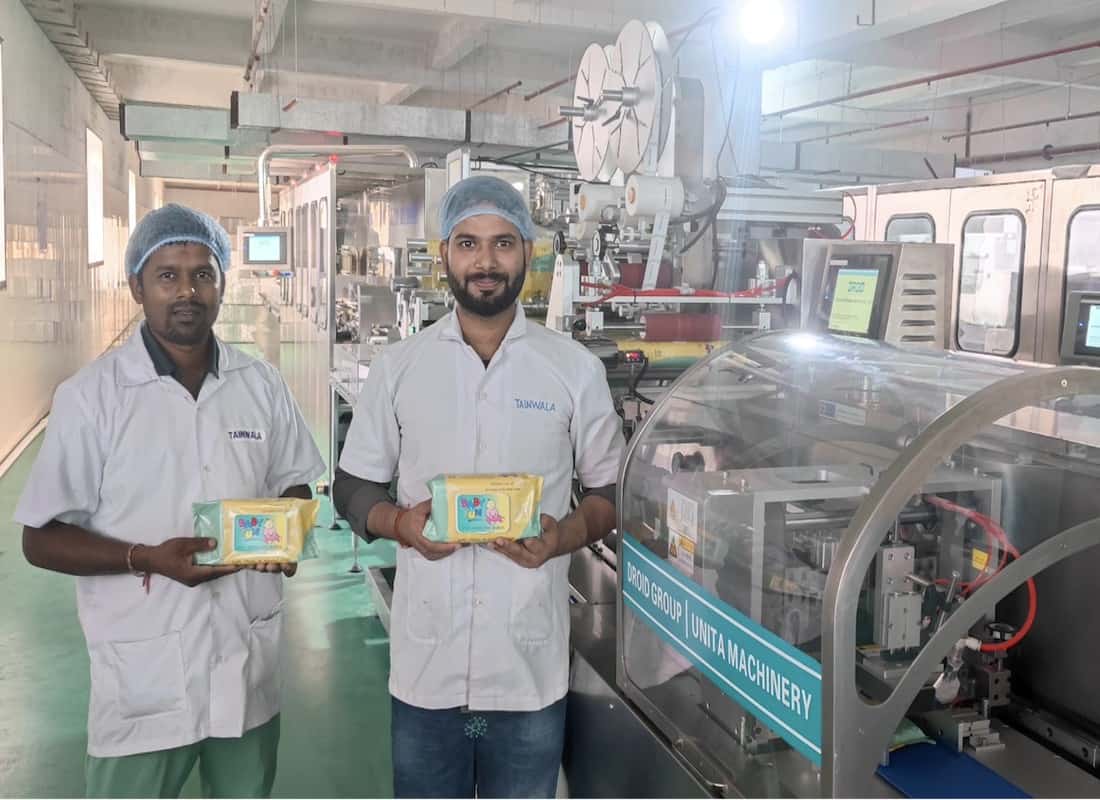1. Comprehensive Training Programs
Effective Instruction
The key to creating a secure working environment is ensuring that operators possess extensive knowledge and expertise in their equipment. All operators must undergo comprehensive training programs before being authorized to operate wet wipes manufacturing equipment. These programs must include all facets of the equipment, ranging from fundamental operations to sophisticated troubleshooting approaches. Operators must possess a comprehensive understanding of the machine’s capabilities, including the knowledge of how to initiate, halt, and run it securely under diverse circumstances. Furthermore, the training should include a comprehensive elucidation of the possible dangers linked to the apparatus, with a focus on the significance of adhering to safety regulations to minimize these risks. Emergency protocols should also be a fundamental aspect of the training, guaranteeing that operators are fully aware of the precise actions to take during a malfunction or disaster. By providing operators with this expertise, wet wipes manufacturers may greatly decrease the probability of accidents and guarantee a more streamlined and effective wet wipes manufacturing process.
Practical Application
Although academic knowledge is essential, practical experience is vital in training operators for real-life situations. Supervised practice sessions provide operators the chance to use their acquired knowledge in a regulated setting. During these sessions, operators have the opportunity to get acquainted with the real working circumstances and acquire the knowledge and skills necessary to manage the equipment safely and efficiently. They have the opportunity to engage in activities such as operating and halting the machines, modifying configurations, and executing regular maintenance duties. Supervised practice enables trainers to closely monitor and rectify any errors, so guaranteeing that operators cultivate positive habits right from the beginning. Moreover, these sessions enhance the development of operators’ self-assurance, hence reducing worry and reluctance when they begin operating autonomously. Through the integration of extensive training and practical experience, wet wipes manufacturers may cultivate a proficient staff that can operate wet wipes manufacturing equipment with both safety and efficiency.
2. Personal Protective Equipment (PPE)
Compulsory Personal Protective Equipment (PPE)
Utilizing personal protective equipment (PPE) is an essential element in ensuring safety inside industrial environments, particularly when working with intricate machinery such as wet wipes manufacturing equipment. Ensuring that operators are adequately outfitted with Personal Protective Equipment (PPE) is not just a statutory obligation, but also a crucial precautionary step to safeguard them from any harm. The essential personal protective equipment (PPE) required for the production of wet wipes consists of gloves to protect against cuts and chemicals, safety goggles to shield the eyes from debris and splashes, ear protection to prevent hearing damage caused by loud machinery, and safety footwear to safeguard against foot injuries resulting from heavy objects or slippery surfaces. Every individual piece of personal protective equipment (PPE) has a distinct function, and when used together, they provide a complete shield against the many dangers found in the manufacturing setting. By rigorously implementing the usage of Personal Protective Equipment (PPE), wet wipes manufacturers may substantially reduce the likelihood of workplace accidents, therefore cultivating a safer and more efficient working environment.
Routine inspections
Regular examination of personal protective equipment (PPE) is crucial to guarantee its efficacy and dependability. Personal Protective Equipment (PPE) may deteriorate or sustain damage over time, therefore compromising its efficacy in providing protection. Hence, it is essential to set a regular schedule for examining all personal protective equipment (PPE) components. This procedure should include inspecting for indications of deterioration, such as fissures in safety goggles, rips in gloves, or degradation in ear protection. It is essential to promptly repair any equipment that has been destroyed to provide uninterrupted protection for the operators. In addition, wet wipes manufacturers need to maintain a supply of spare personal protective equipment (PPE) to prevent any disruptions in operations caused by insufficiencies in equipment. Providing training to operators on doing pre-use inspections may significantly improve safety since it enables them to promptly detect and report any potential problems. By giving priority to the regular inspection and maintenance of personal protective equipment (PPE), wet wipes manufacturers can guarantee the ongoing protection of their personnel, therefore reducing the likelihood of accidents and injuries.
3. Routine Maintenance and Inspections
Scheduled Maintenance
Regularly scheduled maintenance is a fundamental aspect of ensuring operational safety and efficiency in all production environments. Regular maintenance of wet wipes manufacturing equipment provides effective working of all gear and timely resolution of any issues to prevent them from becoming significant problems. An effective maintenance program should include routine inspections of vital components, application of lubrication to movable parts, and adjustment of sensors and controls to ensure accurate performance. This proactive methodology aids in the detection of wear and tear, loose fittings, and other indications of possible failure that may result in dangerous circumstances or expensive periods of inactivity. It is crucial to carefully record and strictly follow maintenance schedules, ensuring that detailed records of each maintenance task are maintained for future reference. This documentation serves the purpose of not only monitoring the wet wipes machine’s condition over some time but also guaranteeing adherence to industry standards and safety requirements. By adhering to a strict maintenance regimen, wet wipes manufacturers can prolong the lifespan of their equipment, decrease the chances of unforeseen malfunctions, and maintain a secure working environment for their workers.
Documentation
Thorough documentation of all maintenance and inspection operations is essential for several reasons. Firstly, it offers a historical account that may aid in identifying reoccurring problems and strategizing future maintenance actions with more efficiency. The records should include the dates of maintenance, details of the precise activities carried out, information on the parts that were replaced, and any observations made during inspections. Additionally, thorough documentation facilitates adherence to industry standards and regulatory obligations, which often need evidence of regular maintenance and inspection protocols. Well-documented records may serve as evidence that all required safeguards and procedures were adhered to in the event of an audit or incident inquiry. Furthermore, documentation functions as a great teaching asset for newly hired maintenance professionals, providing them with vital knowledge about typical problems and efficient remedies. Through the meticulous documentation of information, organizations may guarantee openness, responsibility, and an ongoing process of enhancement in their maintenance procedures, finally resulting in a more secure and dependable production setting.
4. Emergency Protocols and Readiness
Emergency Procedures
Emergency protocols are crucial for guaranteeing a prompt and efficient reaction to any unexpected occurrences that may arise when operating wet wipes manufacturing machinery. It is essential to have well-defined protocols that include several possible situations, such as equipment faults, fire incidents, and chemical spills. Every emergency should be accompanied by a matching action plan that clearly explains the essential measures for operators to safeguard themselves and their colleagues, minimize harm, and facilitate a safe escape if required. These processes must be not only documented but also publicly shown near the equipment for easy and immediate access. It is important to regularly practice drills to ensure that all operators are well-acquainted with the emergency procedures and can carry them out effectively even in high-pressure situations. By implementing and adhering to thorough emergency protocols, firms may mitigate the consequences of catastrophes and improve the overall safety of the workplace.
First Aid Training
An essential aspect of disaster preparedness is providing the workplace with first aid kits and ensuring that some staff members are educated in fundamental first aid techniques. First aid training should include typical injuries that may arise in an industrial environment, including lacerations, thermal injuries, and bone fractures. Proficient individuals with first aid training may promptly provide help in case of an accident, leading to a notable decrease in the severity of injuries and enhancing the chances of a successful recovery. Strategically positioning first aid kits around the building and doing frequent checks to ensure they are adequately supplied and that all goods are within their expiry dates is essential. In addition, it is crucial to provide workers with comprehensive training on the proper use of the first aid kits. By integrating first aid training into their safety standards, firms may guarantee a heightened degree of preparation and reactivity, thereby cultivating a more secure working environment for all workers.
5. Ergonomic Workstations
Ergonomics
Ergonomics refers to the study of designing and arranging objects and environments in a way that optimizes human well-being and performance.
It is crucial to prioritize ergonomics when designing workstations for operators working with wet wipes manufacturing equipment to safeguard their long-term health and productivity. Ergonomics is the study of designing a workstation that reduces physical strain and increases productivity, specifically customized to meet the operator’s demands and comfort. This encompasses the provision of adaptable chair options, which enable operators to maintain correct body alignment, hence diminishing the likelihood of developing musculoskeletal illnesses. Work surfaces should be set at optimal heights to avoid excessive reaching or bending, which may result in back and shoulder problems. Controls and equipment should be conveniently accessible to eliminate needless physical exertion and decrease tiredness. Sufficient illumination is also a vital element since it reduces ocular fatigue and enhances concentration and precision. Wet wipes manufacturers can increase operator comfort, decrease work-related injuries, and boost overall productivity by creating ergonomic workplaces. Implementing an ergonomic approach to workstation design showcases a dedication to the welfare of workers and enhances the safety and productivity of the production environment.
Regular Breaks
Promoting frequent intervals is another crucial element in preserving operator well-being and ensuring safety in a challenging manufacturing setting. Prolonged durations of repeated action or prolonged standing might result in tiredness and elevate the likelihood of sustaining injuries. Implemented intervals provide operators with the opportunity to relax, elongate their bodies, and replenish their energy, therefore reducing the physical and emotional stress linked to uninterrupted labor. Operators have the option to engage in uncomplicated stretching exercises during breaks, which may effectively reduce muscular stress and enhance blood flow. Creating a specifically designated location for breaks that includes comfortable chairs and a calming environment will further amplify the rejuvenating benefits of these pauses. Regular breaks not only decrease tiredness but also enhance attention and focus, resulting in fewer mistakes and improved output quality. Wet wipes manufacturers need to create explicit guidelines about break times and guarantee that all employees strictly comply with them. By giving precedence to regular intervals, wet wipes manufacturers may promote the welfare of their employees, resulting in a work atmosphere that is healthier, more content, and more efficient.
6. Clear Signage and Instructions
Visible Signage
Conspicuous and legible signage is an essential element of a secure and productive workplace, especially in settings where intricate technology such as wet wipes manufacturing equipment is used. Signage is essential for effectively conveying critical safety information, providing guidance to operators, and reducing the risk of accidents. Strategically positioning safety signs around the business is essential for indicating safety zones, dangerous locations, and emergency exits. These signs should have high legibility from a far distance, using prominent typefaces, vibrant hues, and globally understood icons to efficiently and promptly communicate their messages. For example, places that need certain Personal Protective Equipment (PPE) should display conspicuous signage to serve as reminders for workers to don their protective gear. Likewise, signs that indicate areas with a high level of danger, such as those near machinery in motion or high-voltage machinery, should serve as a warning to operators to be careful. Effective signage not only contributes to the maintenance of a secure working environment but also guarantees adherence to legislative requirements. Wet wipes manufacturers may greatly reduce the likelihood of accidents and improve workplace safety by investing in safety signs that are carefully designed and strategically positioned.
Sequential Guidelines
Placing detailed operating instructions close to the equipment is crucial to guarantee that all operators can carry out their responsibilities securely and effectively. The instructions should be succinct, comprehensible, and visually conspicuous, preferably displayed prominently on or near the equipment. The training should include all essential elements of running the equipment, such as methods for starting up and shutting down, regular maintenance duties, and measures to be taken in case of emergencies. Visual aids, like as diagrams and flowcharts, are especially beneficial for elucidating complex procedures and reinforcing textual directives. To accommodate a varied workforce, it is essential to provide instructions in several languages to ensure that all operators can understand and adhere to them. Step-by-step instructions are a significant resource for operators, whether they are new or experienced. These instructions help to minimize mistakes and improve uniformity in operations. Wet wipes manufacturers may promote a more productive and secure workplace by offering explicit and easily understandable instructions, which will guarantee that all operators have the necessary expertise to perform safely and efficiently.
7. Housekeeping and Cleanliness
Environment Cleanliness
Ensuring a clean and orderly work environment is vital for maintaining safety and productivity in a wet wipes manufacturing plant. An organized workstation minimizes the likelihood of accidents, such as slips, trips, and falls, which are prevalent in industrial environments. It is important to create regular cleaning plans to guarantee that all spaces, such as manufacturing floors, storage rooms, and common areas, are maintained in a neat and debris-free condition. This includes doing routine duties such as cleaning and mopping floors, wiping surfaces, and appropriately organizing equipment and supplies. In addition, it is important to routinely clean machinery and equipment to avoid the accumulation of dust and residues that may disrupt their functioning. Allocating distinct cleaning duties to staff members might enhance the likelihood of consistent completion of these activities. An immaculate atmosphere not only heightens safety but also promotes overall efficiency by avoiding interruptions and maintaining excellent working circumstances. By placing cleanliness as a top priority, wet wipes manufacturers may establish a work atmosphere that is more agreeable and efficient, resulting in advantages for both employees and the production process.
Waste Management
Effective waste management is an essential component of maintaining cleanliness and ensuring safety and hygiene in the workplace. To minimize the accumulation of waste items such as scrap, packaging, and chemical residues in the work area, it is important to dispose of them in designated bins and containers. A well-defined waste management plan is crucial since it provides detailed guidelines for the proper segregation and disposal of various forms of trash, including hazardous substances. It is important to provide training to employees on these practices in order to guarantee adherence and avert any instances of contamination or mishaps. Scheduling regular garbage collection and removal from the facility is necessary to prevent overfilling and maintain cleanliness and accessibility in disposal locations. In addition, the organization may create recycling initiatives to minimize the environmental consequences of trash and encourage sustainable behaviors. Through efficient waste management practices, organizations may maintain a workplace that is safer, cleaner, and more ecologically sustainable, therefore promoting the overall welfare of their workers and the community.
8. Safety Audits
Regular Audits
Regularly conducting safety audits is crucial for detecting and addressing possible dangers in a wet wipes manufacturing plant. Safety audits include a comprehensive assessment of the workplace, equipment, processes, and operator conduct to verify adherence to safety regulations and pinpoint opportunities for improvement. Trained safety specialists should conduct these audits to objectively evaluate the environment and provide practical solutions. Inspectors will conduct an audit to assess the correct use of personal protective equipment (PPE), compliance with operating protocols, the state of machinery, and the efficacy of safety signs and instructions. In addition, they will assess maintenance records and examine the level of preparedness for emergency response. Conducting regular audits enables the identification and resolution of possible concerns before they escalate into accidents or interruptions, promoting a proactive approach to ensuring workplace safety. Through a steadfast commitment to regular safety audits, firms may continually enhance their safety protocols, safeguard their workforce, and maintain a superior level of operational proficiency.
Feedback Loop
Establishing a feedback mechanism that enables operators to report safety problems without fear of reprisal is essential for preserving a secure work environment. Promoting transparent communication and aggressively soliciting input from operators may provide useful insights into possible risks and areas for improvement. An ideal feedback system should include a user-friendly interface, provide the option of anonymity if required, and be treated with utmost seriousness by the management. Upon receiving reports of safety concerns from operators, it is essential for management to swiftly react by conducting thorough investigations and taking necessary remedial steps. Additionally, it is possible to organize regular meetings or safety committees in order to evaluate input and engage in discussions on safety performance. By cultivating a culture that prioritizes safety and encourages transparent communication, wet wipes manufacturers may promptly and efficiently handle possible concerns, resulting in a workplace that is both safer and more conducive to support.









